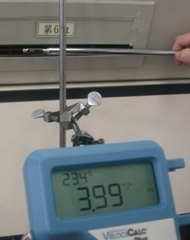|
(A)general waste disposal
1."Recyclables:
Classified into paper, bottles and cans, and glass. If there are oil
stains or contamination, clean them and place them in the laboratory
recycling area (Figure 1) for sorting and storage before transporting to
the school recycling area for centralized processing."

(Figure 1) Recycling Area
2.general
waste
After each
class, the assigned student on duty gathers all the trash and places it
in the school waste bin, which is then centrally processed.
(B)The
classification and disposal of experimental waste
1.Aqueous
Solution Waste:
Storage: Store for later outsourcing and treatment.
Disposal: Outsource for proper treatment.
2.Organic
Liquid Waste:
Storage: Store for later outsourcing and treatment.
Disposal: Outsource for proper treatment.
3.Hazardous
Gas Emissions:
Control: Use local exhaust systems and overall ventilation equipment.
Disposal: Implement local exhaust devices and overall ventilation
systems to manage and mitigate hazardous gas emissions.
一、The
treatment methods for aqueous solution waste:
1.
The
commonly used aqueous solutions in this laboratory, such as saturated
saline solution, sulfuric acid, hydrochloric acid, sodium hydroxide,
sodium bicarbonate, calcium chloride, magnesium sulfate, etc., can be
diluted with a large amount of water and discharged to the school's
wastewater treatment tank for processing.
2.The
aqueous waste generated during other extraction processes, containing
small amounts of organic solvents, is classified according to the waste
compatibility chart and poured into the aqueous waste container.

(Figure 2) Fume Hood for Waste Liquid Treatment
二、The treatment methods for organic
liquid waste
1.In
the organic chemistry laboratory, there is a covered "Rinse Solution
Collection Bottle" beside each sink, intended for collecting acetone
rinse solution. After each experiment, the assigned student on duty
gathers them and centralizes the collection in the waste liquid
treatment fume hood (Figure 2). The collected solutions are then
classified according to the waste compatibility chart and poured into
the "Non-halogenated Organic Waste" container.
2.The
organic waste generated during the experimental process is divided into
halogenated (e.g., organic solutions containing dichloromethane) and
non-halogenated (e.g., ether, acetone, hexane). These must be poured
into graduated cylinders inside the waste treatment fume hood.
Throughout the experiment, the fume hood exhaust system should remain
operational. At the end of the experiment, the assigned student on duty
will systematically pour the waste from the graduated cylinders into the
waste container. After proper handling, the waste container lid should
be securely closed before turning off the fume hood exhaust system.
3.Once
the full waste container is clearly labeled, it is temporarily stored
beneath the fume hood in a storage cabinet. It will remain there until
further notice from the facility management, indicating when it should
be outsourced for transportation and disposal.
三、Toxic Gas Emission Treatment Methods
Accessing
high-concentration and highly volatile organic solvents should be
conducted in the fume hood (Figure 3).

(Figure
3) Volatile Drugs and Organic Solvents.
In addition, above each workstation in the organic
chemistry laboratory, there is an exhaust vent (Figure 4). Students can
use this ventilation system to promptly remove toxic gas generated
during the experimental process. The ventilation equipment is also
regularly inspected (Figure 5) to ensure its effectiveness in removing
fumes.


(Figure 4)
(Figure 5)
|




